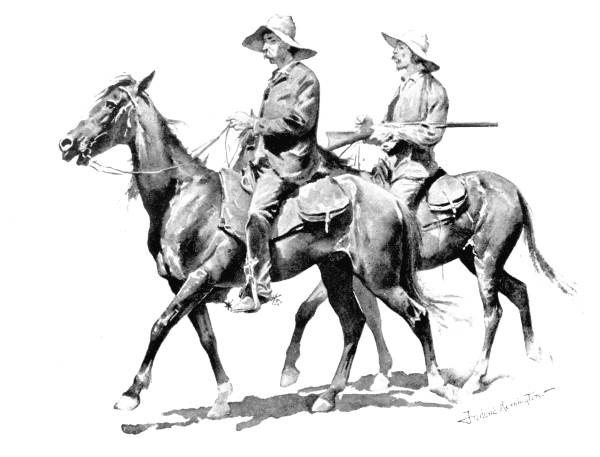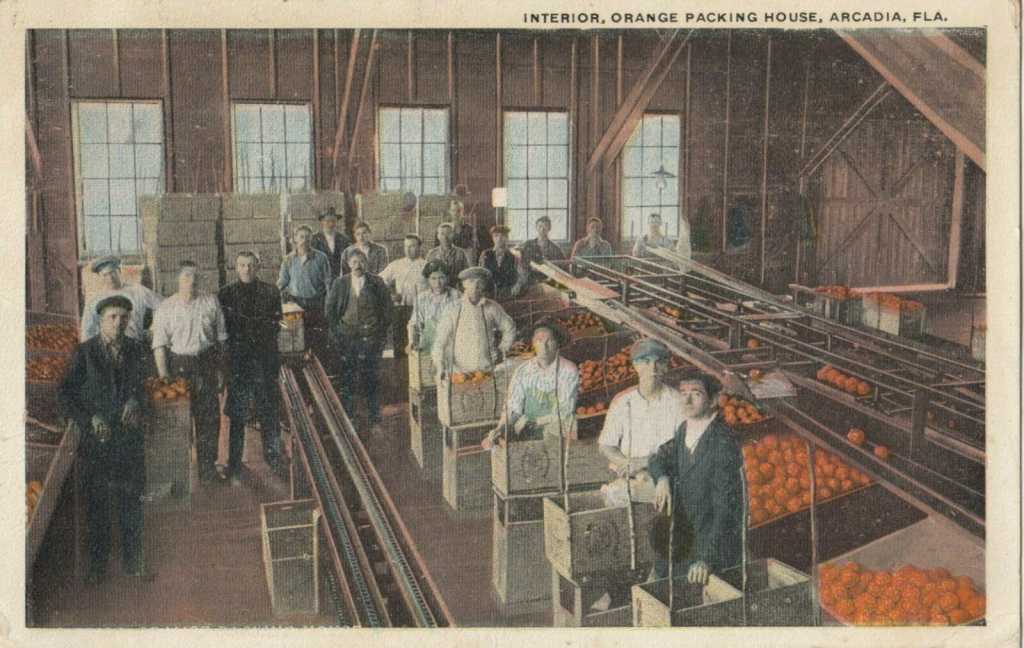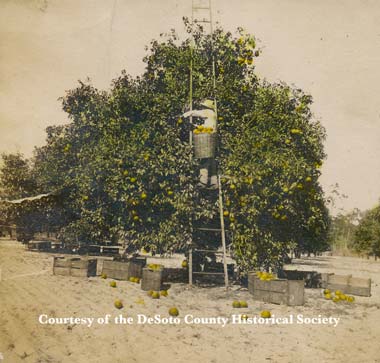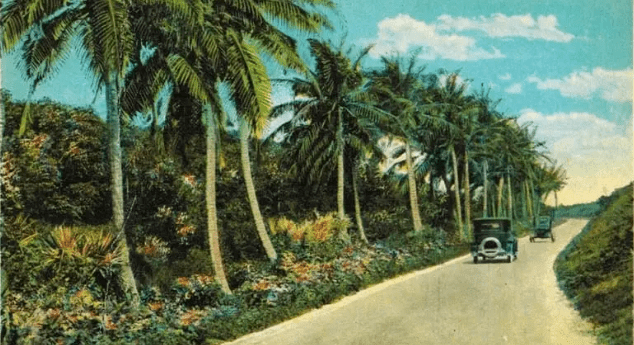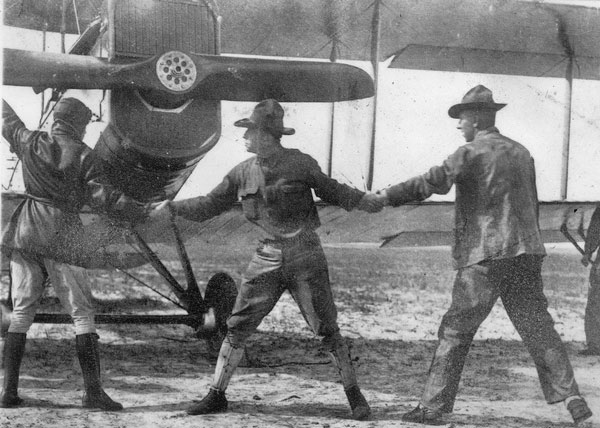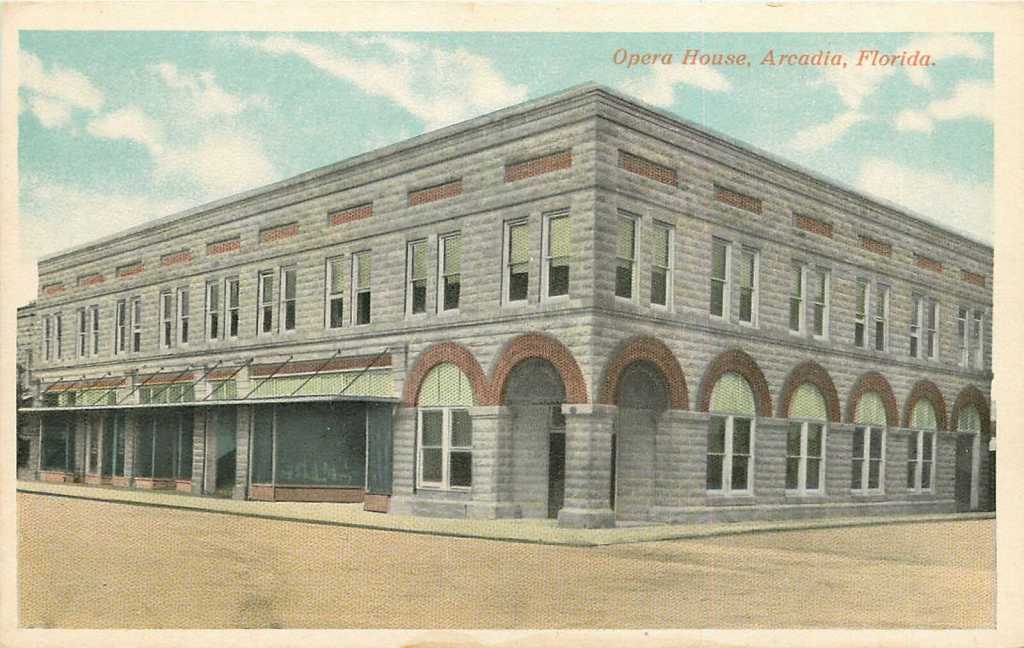
History of DeSoto County
As a result of the First Seminole War (1817-1818), Florida became a U.S. Territory in 1821. The area that is now DeSoto County was originally in St. John’s County, which encompassed the entire peninsula, and St. Augustine was the county seat. In 1824, this area became Alachua County as split from St. John’s County, and Newnansville (near Gainesville) was the county seat.
In 1834, Hillsborough County was carved from Alachua County, and Tampa was its county seat. At the end of the following year, the Second Seminole War (1835-1842) began. It was the longest, bloodiest, and most costly of the Indian Wars that followed the passage of the “Indian Removal Act” of 1830. At the war’s end, Peace River became the northern boundary of the reservation for the Seminoles not killed or sent west to Indian territory, now the state of Oklahoma.
In 1855, the Third Seminole War (1855-1858) began, and the following year, Manatee County was formed from the southern half of Hillsborough County. The Village of Manatee was the county seat, and Manatee County extended from the Gulf of Mexico to the Kissimmee River and Lake Okeechobee and from southern Tampa Bay to the Caloosahatchee River. After the Civil War and during Reconstruction, the Florida Legislature called for a new seat of government at the county’s geographical center. Pine Level was established on April 29, 1866, and a courthouse was built in 1867. The post office opened in 1875, and the plat for the 40-acre town was filed in 1878.


Fort Ogden’s post office, established in 1876
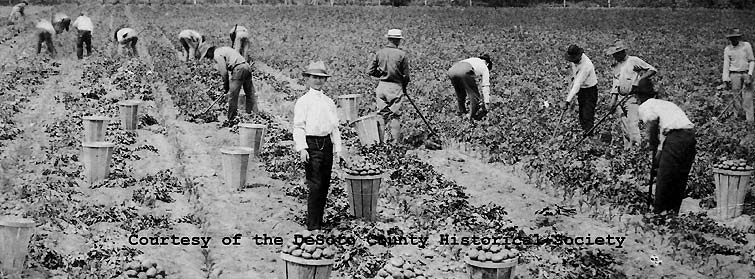
A. J. Doizer Potato Field
Many early pioneers had already settled near Camp Ogden, a fortification built in 1841 during the Second Seminole War in preparation for the U.S. Army to invade the Big Cypress and the Everglades. To make the settlement sound more permanent, the settlers called it “Fort Ogden,” and the Fort Ogden post office, established in 1876, is the oldest in DeSoto County to be in continuous service.
In 1856, the area that is Arcadia today began as a small settlement located on a bluff overlooking Peace River. The river provided transportation, so the area was known as Waldron’s Landing named for early settlers, and then as Raulerson’s Landing, for Harris Raulerson who used to deliver supplies and transport produce–especially potatoes–in his side-wheel steamboat. Many pioneers who hauled their potatoes for shipment began to refer to the area as ‘Tater Hill
Bluff.
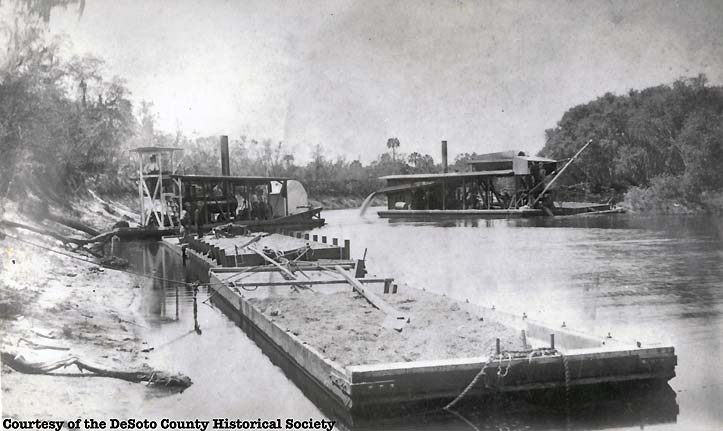
Phosphate Mining Peace River

Florida Southern steam locomotive
In 1881, Captain Francis J. LeBaron of the U.S. Army Corps of Engineers surveyed Peace River and found pebble phosphate in the riverbed. Six years later, his associate T. S. Morehead established the first company to “mine” phosphate from the river. At first, the mineral was extracted with pick and shovel, but later steam-driven dredges were used. By 1908, mining of the river ceased, and companies began strip-mining deposits of phosphate in Polk County.
In 1883, James Madison “Boss” Hendry (1839-1922), a Baptist preacher, moved his sawmill by ox-drawn wagon because of the abundant long-leaf pines that grew on the eastern shore of Peace River. Along the way, he stayed overnight in the home of Thomas H. Albritton and his wife, Frances Albritton. Hendry told the family that his birthday was the following day, so Frances and her daughter Arcadia Albritton Coker baked a cake for him. In appreciation for the kindness, Hendry promised to honor Arcadia by naming for her the town he predicted would arise. In 1883, a post office called Arcadia was established at the settlement near Hendry’s sawmill.
The first train of the Florida Southern Railway arrived in Arcadia on March 4, 1886. Arcadia was the “end of the line” for several months, and during that time, its population increased so much that it was able to incorporate as a town in December. Five years later, in 1901, Arcadia reincorporated as a city.
In 1887, the eastern half of Manatee County formed a new county, was named DeSoto for the Spanish Conquistador Hernando DeSoto. It contained 3,750 square miles, extending from Charlotte Harbor to Lake Okeechobee, from Polk County to Lee County, divided from Monroe County the same year. Pine Level continued as the county seat of DeSoto County until Arcadia was chosen on November 6, 1888.
Fort Ogden, Brownville, Nocatee, Punta Gorda, Pine Level, and Arcadia had been contenders for county seat–with Nocatee as the favorite. When several communities were quarantined because of yellow fever, voting was postponed. On August 4, a second vote did not result in a majority choice. A third vote in November chose Arcadia. In 1921, DeSoto County was divided into the present-day counties of Charlotte, DeSoto, Glades, Hardee, and Highlands.

Seaboard Air Line Arcadia Depot
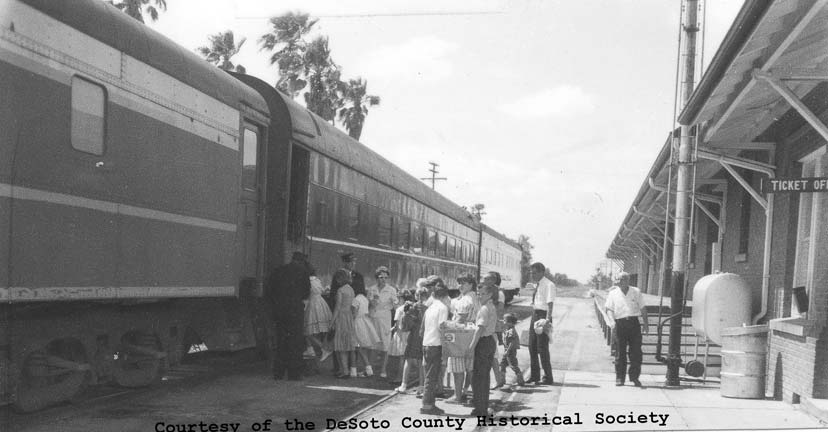
Atlantic Coast Line Arcadia, 1971
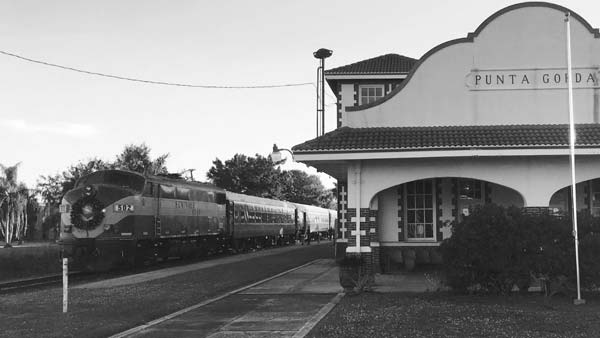
Seminole Gulf Railway, 2019
In 1892, Henry Plant gained control of the Florida Southern Railroad, and added it to the Plant System. Several years after his death, it became part of the Atlantic Coastline Railroad in 1902. Service continued until 1971. Built in 1927, the “Fort Ogden Extension” of the Tampa Southern Railroad, an ACL subsidiary, ran northwest from Southfort (south of Fort Ogden) to Sarasota until operations were suspended during the Great Depression.
The Charlotte Harbor and Northern Railroad was established in 1907 so that freight trains could haul phosphate to the deep-water port of Boca Grande, and it became part of the Seaboard Air Line in 1925. In 1914, the Seaboard built the East and West Coast Railroad as a subsidiary to haul lumber and turpentine between Arcadia and Bradenton. The first train arrived in Arcadia on March 15, 1915, and service was discontinued in the 1930s.
In 1967, the Seaboard Coast Line Railroad consolidated the Seaboard Air Line and the Atlantic Coast Line routes. Today, the Seminole Gulf Railway follows the old Atlantic Coast Line tracks from Naples to Arcadia (https://www.floridarail.com/about-us). CSX Transportation operates the old Charlotte Harbor and Northern tracks from Arcadia to Bradley Junction (https://www.csx.com/index.cfm/customers/maps/csx-system-map).
During the Civil War, the Peace River Valley supplied cattle to the Confederate Army. Herds prospered throughout the nineteenth century, and many were driven to Charlotte Harbor and shipped to Cuba. The so-called “range wars” raged in the nineteenth century’s last decade, and Arcadia once had a reputation as a frontier town as “wild” as any in the American West. In 1895, Frederic Remington visited Arcadia. He wrote and illustrated an article about the era, “The Cracker Cowboys of Florida,” that was published in Harper’s Magazine.
Since 1929, the heritage of stock-raising has been celebrated annually during the Arcadia All-Florida Championship Rodeo. In 1939, the Arcadia State Livestock Market opened and continued operation until 2005. By the end of that year, the privately owned Arcadia Stockyard had opened (http://www.arcadiastockyard.com/history). Today, Florida ranks 12th in the nation in the number of beef cows, and DeSoto County is one of the most productive counties (https://www.nass.usda.gov/Statistics_by_State/Florida/Publications/Brochures/FL%20Cattle%20Broc%202022.pdf).
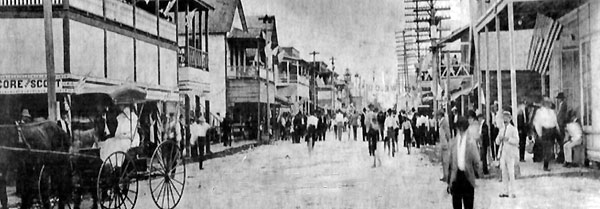
Before Arcadia Fire 1905
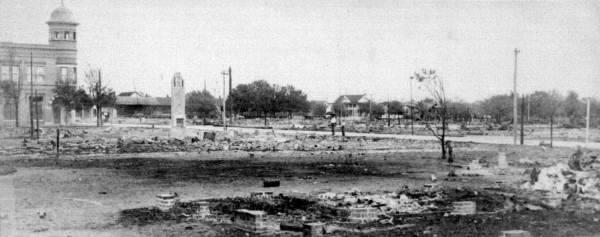
After Arcadia Fire 1905

DeSoto Avenue After Rebuilding
On Thanksgiving Day, November 30, 1905, downtown Arcadia burned to the ground in three hours. Only three brick structures (which still stand today) survived the conflagration: the First National Bank, Seward’s General Merchandise Store, and the D. T. Carlton Building. The loss of forty-three wood structures and their contents was valued at $250,000. On December 1, Arcadian’s agreed that all future construction will be brick or block, and Arcadia’s beautiful downtown is the result.
Arcadia’s only Newspaper, “The DeSoto County News”, was also a victim of the flames. Their offices and printing press had perished, but it didn’t prevent the newspaper editor from “reporting the news”. He boarded the first train north to Zolfo Springs and went to the offices of the “Zolfo Springs Advertiser” where he published an extra edition, the “DeSoto County News” (on December 1, 1905) and reported Arcadia’s losses, dismay and shock.
That account of the fire follows:
Today (Friday) Arcadia presents a scene of ruin and desolation rarely ever visited upon a city. Where yesterday stood substantial business houses well filled with merchandise now repose a bed of smoldering ashes.
Today, businessmen who were yesterday counted financially strong are again poor and are preparing to again begin life after a few short hours’ ravages of the fire fiend.
About 8:30 last night fire was discovered enveloping a small stable in the rear of Gore & Scott’s store, and, in about three hours, nearly every business house in the city and several residences were in ruins.
The fire had gained considerable headway before it was discovered; and, assisted by a strong wind blowing toward the main business houses of the town, soon communicated the flames to Gore & Scott’s store, and it was soon seen that, with no effective means of fighting the flames at hand, the town was doomed. Gore & Scott’s big building was soon a mass of roaring flames and, in a few minutes, had ignited the buildings west across the street and the buildings adjoining on the east. From there the fire rapidly swept east two blocks on each side of Oak Street to the railroad and south one block to and including the “DeSoto County News” building and three residences south across the street. Here the flames were finally checked at Heard & Reynolds’ packing house after a fierce fight.
In all, forty-three buildings were burned, all excepting three brick business buildings.
Citrus is another important industry, and DeSoto County is Florida’s second highest citrus-producing county (https://www.nass.usda.gov/Statistics_by_State/Florida/Publications/Citrus/Citrus_Summary/Citrus_Summary_Prelim/cit90821.pdf). Before the advent of juice concentrate, most fruit was sold fresh, and packing houses operated in Arcadia, Nocatee, and Fort Ogden as well as the county’s smaller communities. By 1926, Arcadia had a cannery for fruit juices. Now most fruit grown in DeSoto County is processed into frozen concentrate, some at the Peace River Citrus Products processing plant.
In 1917, the Dixie Highway was routed through downtown Arcadia. Established in 1914, the highway was built to connect Michigan to Miami. As in the Midwest, Florida had both an east and west route, and south of Kissimmee, the west route followed what is U.S. Highway 17 today and then the Tamiami Trail (aka U.S. Highway 41). Until the Trail was completed in 1928, the Dixie Highway followed State Road 70 across the state.
Arcadia’s building “boom” of the 1920s produced commercial structures as well as a new city hall, a concrete bridge with electric lights (beautifully restored by the Florida Department of Transportation in 2020), many subdivisions, a nine-hole golf course–today’s Arcadia Municipal Golf Course, and the Arcadia Tourist Camp, now the City Mobile Home Park, home of the “Tin Can Tourists of the World” Conventions from 1924 until 1931. Built in 1928, the colossal All-Florida Chautauqua amphitheater had only 1 season in January-March 1929. The ruins are located on the grounds of Peace River Campground.
In 1931, George K. End founded the Floridian Products Corporation, just outside Arcadia. He “milked” the snakes for their venom. He canned and sold rattlesnake meat at the “World’s Only Rattlesnake Cannery.” He sold shoes, belts, jackets, and skirts fashioned from the skins; souvenir heads, skulls and fangs; bone bracelets and anklets; plus rattlesnake oil and other medicinal products. In 1937, he moved his operation to Tampa where he operated the “Rattlesnake, Florida,” post office.
During the Great Depression, Arcadia began construction of a municipal airport with Federal Emergency Relief Act (FERA) funds—today’s Arcadia Municipal Airport (https://arcadia-fl.gov/departments/arcadia-municipal-airport-x06). FERA also funded a beef cannery at the Florida Baptist Children’s Home (located in Arcadia from 1903 to 1948). Works Progress Administration (WPA) projects included the construction of a U.S. Post Office in 1937 (complete with WPA artwork, “Arcadia” by Constance Ortmayer), a sewing room, and re-construction as a cafeteria/gymnasium of the old “Arcadia Public School” built in 1906.
During World War I, the U.S. Army built two aviation training camps to the southeast and east of Arcadia, on today’s State Roads 31 and 70, respectively. They were named Carlstrom and Dorr fields in honor of two aviators who had died in 1917. First Lieutenant Victor Carlstrom was a flight instructor who was killed while teaching cadets in Newport News, Virginia. Private Stephen H. Dorr joined the Officer’s Reserve Corps in Fort Myers and crashed while training with the Royal Flying Corps near Toronto, Canada. Charles Kettring tested his unmanned “aerial torpedo”–a forerunner of the “smart bomb”–in 1919 at Carlstrom Field. A model of the “Kettring Bug” is on display at the Arcadia Municipal Airport.
Both fields were re-activated by the Embry-Riddle Aeronautical Corporation as primary training schools prior to the U.S.’s entry into World War II. The British Royal Air Force sent cadets for training at Carlstrom and other fields in southwest Florida. Twenty-three of them who died were buried in Arcadia’s Oak Ridge Cemetery. The cadets are honored every Memorial Day in a service conducted by the Arcadia Rotary Club.
After World War II, Carlstrom Field was developed into G. Pierce Wood Memorial Hospital, a state institution for mentally ill patients. It closed in 2002 to make way for the DeSoto Correctional Facility for Juveniles, which closed in 2010. Dorr Field was initially also redesigned as a state mental hospital, and then was used as a training center. In 1969, it became DeSoto Correctional Institution.
Residents of Arcadia and DeSoto County have invented and patented many items used today. In 1895, Thomas Gaskins invented the automatic railroad car coupler; his son, also Thomas Gaskins, devised Gator Roach Hives, a precursor of the popular “roach motel”; Frank Cline designed hydraulic track adjusters used for military tanks as well as the Cline Rolling Straight Edge for road paving; Lewis Bishop innovated the rotary lawn mower, crop sprayer, cultivator-seeder, among other machines; Carl Fenton designed a cattle feeder that functioned as a weather vane to keep feed or mineral out of the weather; and Thomas Jessup invented a plow to dig up the roots of saw palmettos. Many other inventions remain curiosities.
In 1984, Arcadia became a Main Street City, and revitalization of downtown–with antique shops filling the historic stores–began in time for the City’s centennial. The DeSoto County Historical Society was founded to assist in that celebration, and continues to preserve and promote the history of DeSoto County for future generations.
The Main Street Program was renewed in 2005, following the hurricanes of 2004, including a direct strike from Hurricane Charley. (In 1960, Hurricane Donna had toppled the decorative arches and urns of the Plaza Hotel, the only 1920s-era hotel still standing.)
In 2009, Barack Obama was the first sitting president to visit DeSoto County when he arrived to view the largest solar-generating power plant in the state. Other visitors canoe or kayak Peace River or shop for antiques. On the fourth Saturday of the month, the Antique Association hosts one of the largest antique fairs in the state, with more than 100 dealers.
DeSoto County’s economy also relies on its historic industries: agriculture, cattle ranching, citrus groves (and processing), and plans to strip-mine phosphate. Residents are proud of the past, and trust in our heritage to provide a pathway to the future.


